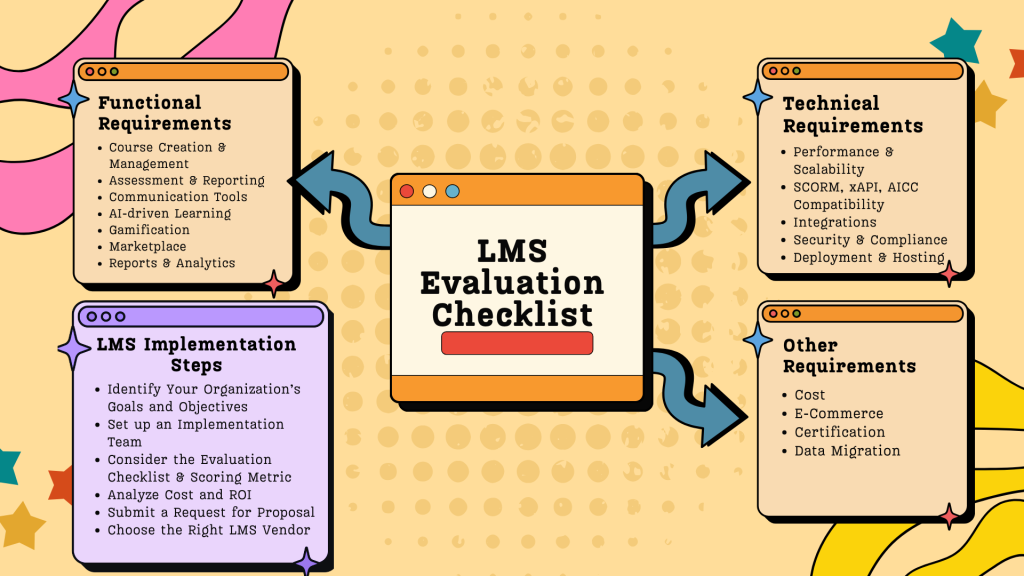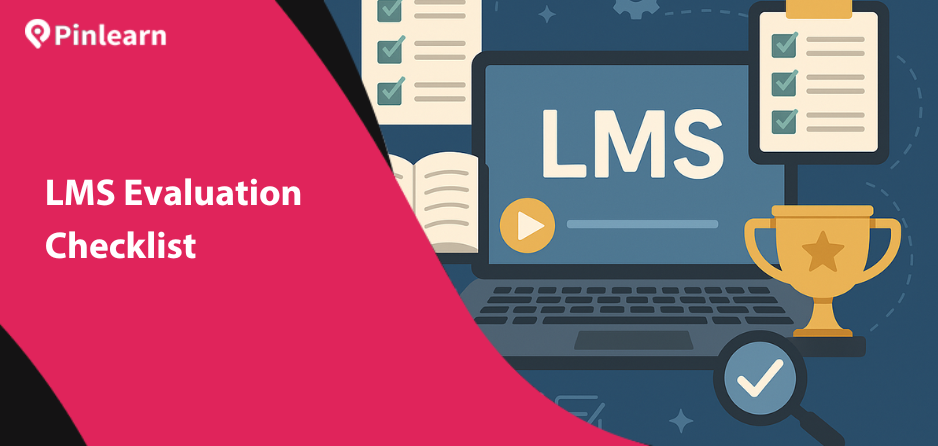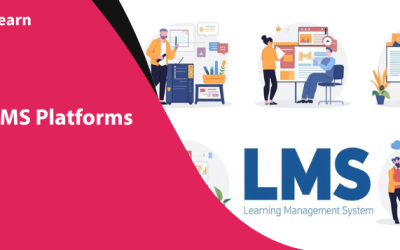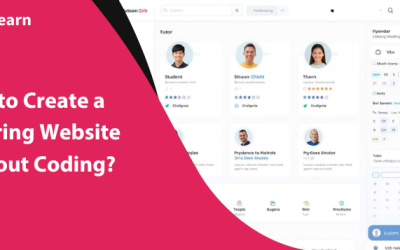LMS Evaluation Checklist: Criteria & Comparison Guide
Whether you’re choosing LMS for compliance management or partner training, picking the right one is crucial. There are many platforms with different features and use cases. This makes the selection process all the more confusing!
But a clear checklist with all the essential comparison points gets you sorted through the process. This is called an LMS evaluation checklist. For organizations, this list comes in handy for the LMS implementation process.
What you’ll find in this evaluation guide:
- What is an LMS evaluation checklist? Why Do You Need One?
- LMS Evaluation Checklist: Key Criteria
- What are the Key Steps for LMS Implementation?
So, let’s dive in!
What is an LMS Evaluation Checklist? Why Do You Need One?
First, let’s define the LMS evaluation checklist.
An LMS evaluation checklist is a document or an organized list with all the essential criteria or factors to compare different learning management systems and choose the one that best fits your organizational needs.
Choosing an LMS is a critical decision for every organization. Hence, the process begins with extensive planning & analysis. The first step is to know what exactly your organization needs, this helps to create a well-aligned evaluation checklist.
Here’s why you need an LMS evaluation checklist:
- Systematically compare different LMS platforms based on factors and business needs
- Ensures you don’t overlook or miss any features or aspects
- Saves your time and reduces human errors
- Consistency through the entire selection process
- You involve the entire team and key stakeholders in the selection
LMS Evaluation Checklist: Key Criteria
Here are the key criteria for LMS evaluation:

1. Functional Requirements
Essential Features & Functionalities
First off, let’s begin with the core features and functionalities. The basic goal of an LMS is to create, track, deliver and report educational content and training programs. Let’s focus on each of the core features briefly:
- Course Creation & Management: Whether you’re creating slide-based courses, microlearning content, or training videos, an LMS allows you to create, organize, and manage your content. LMS helps to develop content with a native or external authoring tool. Look for an LMS with easy drag-and-drop, course-building features and a library of objects.
- Assessment & Reporting: Quizzes, assessments or tests help to assess students’ progress. Your LMS must provide custom reports on grades, learner progress, course completion rate, etc.
- Communication Tools: Learning is incomplete without effective communication tools. Chats, video conferencing, breakout rooms, and discussion boards improve communication between educators and students.
Artificial Intelligence
The demand for personalized learning is growing more than ever. More LMSs are adopting AI-powered learning paths fine-tuned to learners’ needs. AI-driven content authoring, content recommendations, and predictive analytics are applications of AI in LMS.
AI analyzes learner behaviour (performance, strengths, weakness) and makes smart content recommendations. Plus, adaptive assessments, grading assignments, and built-in AI gamification motivate learners to achieve better outcomes.
User Experience
A great UX encourages learners to smash goals and instructors to easily create and deliver content. Whether it’s clean navigation, immediate feedback, or inclusive learning, good UX makes all the difference!
Here are different elements to consider for LMS UX:
- Intuitive & Seamless Navigation: Intuitiveness is all about easily finding what users are looking for on your LMS. Navigation menus, search bars, and dashboard summaries reduce friction.
- Mobile Optimization: Ensure LMS is optimized for mobile learning and accessible from all devices and locations. Thus, learning happens on the go from even tablets, desktops or mobile devices.
- Accessibility: Your LMS should be accessible to all users regardless of their disabilities. Adhere the WCAG 2.1 standards to make learning inclusive for all, even for learners with assistive technologies.
- Customization & Branding: If unique branding is one of your priorities, focus on an LMS that delivers a branded learning experience. LMS must allow adding logos, brand fonts, custom certificates, and even personalized workflows. This delivers your organization’s messaging and goals to people.
- Multi-lingual & Localization Support: Learning in a global workforce demands support for various language translations. The course content, navigation menus, notifications, and certifications need to be translated into the preferred language. Right-to-left language support and translating to localized context deliver relevant content.
- Onboarding: In-depth guides, tooltips, demos, and tutorials streamline onboarding onto the LMS.
- Visual Cues: Progress bars, tooltips, and completion badges all keep the engagement ongoing and provide a sense of direction.
Gamification
Incorporating gamified elements into learning drives learner engagement. Leaderboards, points, badges, quizzes, and even educational games make learning fun and also a sticky experience!
A gamified environment transforms goals into interactive learning experiences. Look for an LMS with gamified elements that incentivize learning and build personalized paths.
Some LMSs turn structured tasks into milestones and rewards. A few other LMS include role-play scenarios, real-world scenarios, or challenges. Choose one that aligns with your business needs.
Marketplace
An extensive content library in your LMS saves your time as you don’t need to build content from scratch. There are pre-built courses curated by industry experts that meet every need from compliance and sales training to upskilling.
Top LMSs provide courses and training materials for popular certifications and address skill gaps. Further, ready-made course templates for diverse learning make course creation easy and less time-consuming.
Reports & Analytics
With the right metrics and analytics, businesses can gain real-time insights into training programs, learner progress, engagement, etc. User engagement, assessments, course progress, and learner proficiency are some of the key LMS metrics.
These valuable insights help to identify the skill gaps and fine-tune your learning programs. By measuring the effectiveness of your e-learning courses, you can understand which ones are engaging and which ones need to be optimized.
Support
Along with features and functionalities, ongoing support is another aspect to consider. To maximize the functionality of LMS, ongoing support is crucial. Regular updates, data backup, troubleshooting, and system upgrades are few essential aspects for LMS support.
Ongoing support is offered through different channels, such as live chat, email, and phone support. Additionally, FAQ, forums, and a Knowledge base are indispensable for extensive support.
From launch and onboarding to admin support, find an LMS offers a seamless user experience!
2. Technical Requirements
While you might think it’s too early to consider technical requirements, this is necessary for future growth!
Below are some tech considerations for a highly efficient and seamless LMS:
- Performance & Scalability: A high-performing LMS loads, processes and delivers content quickly and offers a smooth learning experience. Ensure your LMS can handle a surge in users, content and data. Scalability is another aspect where the LMS must cater to the organization’s growing needs.
- Compatibility (SCORM, AICC, xAPI): E-learning standards are essential for interoperability, content effectiveness and tracking. SCORM, AICC, and xAPI are modern content standards. Evaluate if your LMS supports these standards for scalability, flexibility, and seamless flow of content.
⚡ Related: SCORM vs. xAPI
- Integrations: Ensure LMS integrates with existing CMS, HRIS, collaboration tools and e-commerce platforms. This ensures a robust, data-rich learning ecosystem. LMS integration offers personalized learning, seamless login, and centralized tracking and reporting.
- Security & Compliance: Safeguarding sensitive data and privacy is crucial for organizations. A secure LMS employs robust security measures, such as multi-factor authentication, data back-up, user roles and compliance with GDPR and FERPA standards.
- Deployment & Hosting: Consider whether your LMS is deployed on-premises, cloud-hosted, or self-hosted and assess the ease of maintenance.
Other Requirements
Here are other key requirements to consider when choosing the right LMS:
Cost
Evaluating your overall LMS cost involves not just the subscription price. You need to consider the pricing model, flexible payment options, licensing costs, and hidden fees. Further, integrations and add-on costs ensure you are getting long-term value from your investment.
Cloud-based LMS charges a fixed cost per month, while self-hosted solutions take a one-time cost. The initial setup includes installation, domain and SSL. On the other hand, open-source LMS like Moodle offer free versions, but take considerable cost for setup and integration.
E-Commerce
While traditional LMSs are not designed for e-commerce, modern LMSs flip the script! Buying and selling content, discounts, subscriptions, and bundles are all features that make LMS more exciting. Integration with payment gateway, marketing tools, and affiliate systems are few other features to consider.
Certification
Certifications are every learner’s badge of honour and show completion of their milestone. Even as we move towards adulthood, our fascination with certification never ceases! Automated certificate generation reduces the workload for admins. LMS also offers custom certificates where company logos, authority signature, learner name and course details can be inserted.
Data Migration
Trust us, migrating from another LMS can be tiresome! You need to import learner details, content, login credentials, roles, etc. Further, mapping features, managing compatibility and integrations are a few things down the list! Pick an LMS that ticks all the boxes and makes migration seamless.
What are the Key Steps for Successful LMS Implementation?
While creating an LMS evaluation checklist is crucial, it’s a challenging task! Once you are done with that, you can plan for LMS implementation. From identifying organizational goals and learning objectives to choosing the right LMS vendor, you need a careful implementation strategy.
Here are key steps for LMS implementation:
1. Identify Your Organization’s Goals and Objectives
The first step to begin with the LMS implementation process is to ask — Why do you need an LMS? Determining the purpose of your LMS makes the next steps easier.
For example, you might need an LMS for compliance, customer training, or even employee upskilling.
Next, identify the objectives or how the LMS would benefit your organization. This could be like reducing training cost, addressing skill gaps, or improving learner engagement.
2. Set up an Implementation Team
Secondly, build a robust LMS implementation team or committee. Involve the key stakeholders for LMS decision making, including the L&D team, HR, senior leadership, IT, instructional designers, and product leads in the process. You can benefit from their valuable insights and suggestions to pick the right LMS for your organization.
3. Consider the Evaluation Checklist & Scoring Metric
Finally, it’s time to make the most of the LMS evaluation checklist you had created earlier! You have already listed the functional and technical requirements in the checklist. Now, it’s time to assess each LMS for all its requirements and assign a weighted score. Now, this process needs some groundwork, gathering information from the LMS’s website, existing customers and review sites.
💡 Want to know the best LMS platforms? Check our curated list of top LMS picks:
4. Analyze Cost and ROI
You must have already set a clear budget for LMS. Compare different LMS for pricing model, customizations, licensing, and add-ons. Also, look for hidden costs, recurring charges, onboarding support and upgrades. Check if the LMS is cost-effective and aligns with overall value and ROI.
5. Submit a Request for Proposal
Once you have determined a potential LMS, it’s time to submit a request for proposal (RFP) document. This outlines all the necessary requirements for your organization’s LMS.
Typically, it includes a project summary, essential features, expected implementation time, scalability, etc. The vendor then evaluates if the demands align with their product and sends a response. In this stage, also request any possible demos or trials to grasp how the LMS works!
6. Choose the Right LMS Vendor
Once you get a response from the vendor, decide if the LMS is feasible for your organization’s needs. If the LMS isn’t the right fit, you move on to the next option until you find the right one. With the RFP process, you come to terms with the vendor’s support, response time and communication.
The LMS evaluation checklist, reviews, and demos help you to pick the ideal LMS for your business.
The Bottom Line
Choosing the right LMS impacts your overall organizational development and business revenue. Hence, making a well-informed decision is all the more important! An LMS evaluation checklist is an effective tool to pick the right LMS for your organization.
Typically, organizations create it considering all the essential functional and technical requirements. When you identify your organizational goals and objectives early, your evaluation checklist clearly drives business success.
We have outlined an effective 6-step implementation process that builds an empowering LMS. By following all the above steps, you can develop an LMS that aligns with your needs and accelerates your organization’s growth!
FAQ-Related to LMS Evaluation Checklist
1. How to evaluate an LMS?
To evaluate an LMS, you need to consider different key factors, such as user experience, course creation, communication tools, reporting & analytics, integration, cost, etc. Start the evaluation process by identifying your organization’s needs and objectives.
2. What are the top criteria for evaluating an LMS?
These are the top criteria for picking the right LMS:
- User Experience
- Course management & progress tracking
- Integrations with existing systems and external tools
- Scalability to accommodate users, content, and a growing tech stack
- Cost & Budget
- Reports & analytics to track course completion, learner progress, and make data-driven decisions
3. How do I evaluate LMS scalability?
To evaluate scalability, consider if your LMS can:
- Handle an increase in users, courses, or data
- Multi-tenancy support
- Integration & API scalability
- On-premise or cloud hosting
- Multi-lingual support and localization
- Support & pricing model
4. What are the essential functional requirements of an LMS?
The functional requirements of an LMS are:
- Course creation and management
- Progress tracking & analytics
- Communication & Social learning
- Mobile learning
- Gamification
- User experience
- SCORM, xAPI, and AICC Compatibility





